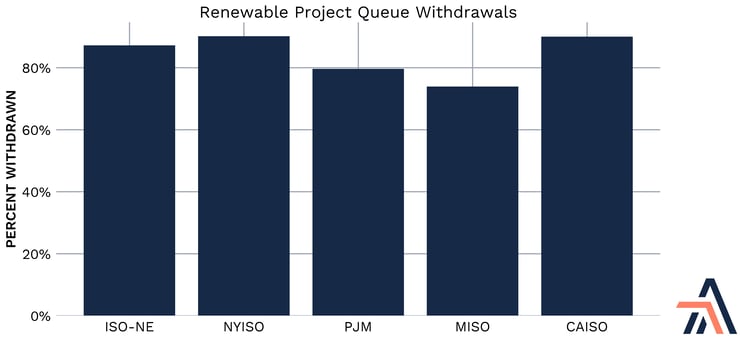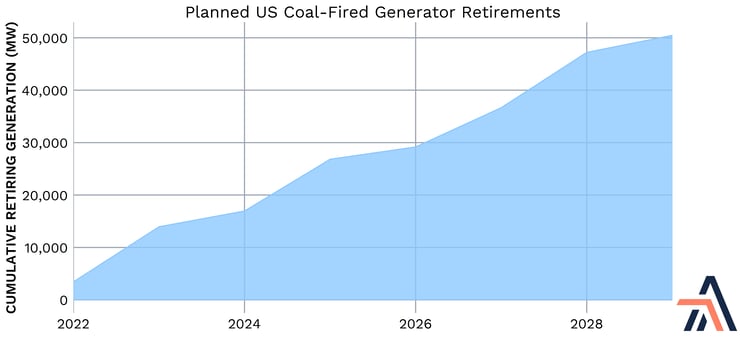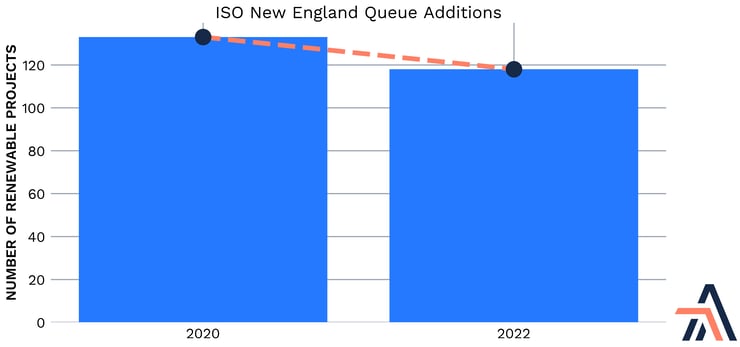The Resiliency Problem Facing Our Critical Energy Infrastructure: Two Ends of the Spectrum
Originally published for customers January 13, 2023.
What’s the issue?
As climate change poses a growing threat to our infrastructure system, renewables are expected to make up significantly more and more of the nation's energy mix. But this push for low carbon solutions comes at a rate outpacing the supply of renewable technology.
Why does it matter?
For a state with a nearly unlimited supply of oil and gas, Texas’s energy mix is surprisingly renewable generation heavy — around 26% — a goal many states are striving for. Yet its residents have experienced severe power shortages and high energy prices resulting from supply shortages, especially during times of peak demand such as extreme weather events.
To meet national 2030 decarbonization goals, a 62% gap in renewable projects already exists, and the push to retire coal plants and other heavy carbon emitting fuel sources worsens the existing strain on our infrastructure system. As renewable projects begin to be incentivized, conceptualized and developed at a faster rate, the U.S. must come to better terms with the issue of resiliency.
What’s our view?
While Texas implemented some thoughtful changes in response to Winter Storm Uri, other states with lofty renewable goals — like in New England — have not followed suit. Similar power crises will likely persist across the country until such action is taken.
As climate change poses a growing threat to our infrastructure system, renewables are expected to make up significantly more and more of the nation's energy mix. But this push for low carbon solutions comes at a rate outpacing the supply of renewable technology.
For a state with a nearly unlimited supply of oil and gas, Texas’s energy mix is surprisingly renewable generation heavy — around 26% — a goal many states are striving for. Yet its residents have experienced severe power shortages and high energy prices resulting from supply shortages, especially during times of peak demand such as during extreme weather events.
To meet national 2030 decarbonization goals, a 62% gap in renewable projects already exists, and the push to retire coal plants and other heavy carbon emitting fuel sources worsens the existing strain on our infrastructure system. As renewable projects begin to be incentivized, conceptualized and developed at a faster rate, the U.S. must come to better terms with the issue of resiliency.
While Texas implemented some thoughtful changes in response to Winter Storm Uri, other states with lofty renewable goals — like in New England — have not followed suit. Similar power crises will likely persist across the country until such action is taken.
The Outlook for U.S. Electricity Generation
In 2022, 22% of electricity came from renewable sources across the country, with those numbers estimated to reach as high as 50% by 2030. Currently, national queues show over 335,000 MW of capacity in the development pipeline, but this accounts for just about half of what’s needed — a total of 756,102 MW.
As seen in the chart below, historically over 84% of renewable projects that enter the queue to connect to the grid are withdrawn and never actually built. All else being equal, we are thereby left with a 62% gap to reach those goals.

As we wrote about in Environmental Purists Drive New England GHG Emissions Way Up, increased pressure to retire coal power plants has only created more problems for fuel scarce areas of the country.

The chart above shows over 25% of coal plants are expected to be retired by 2030. Combine this deficit with the 62% gap in renewable generation, and there’s significant ground to cover between expectation and reality for our nation’s energy supply.
Power System Reliability
The NERC 2022 Long-Term Reliability Assessment highlights a mounting problem in the U.S. — as renewables constitute a greater portion of America’s generation mix, so comes a need for weatherized infrastructure and reliability assurance. As we noted in NERC Speaks to Future of Natural Gas — Will FERC Certificate and GHG Policies Reflect It?, the risks to reliability only go up as climate change causes increased electric demand across our power system, with the appetite for energy consumption expected to increase 10% by 2030. We’ll also see short-term, localized, crisis-level generation supply reductions caused by extreme weather events due to weather-dependent generation. The obvious fix for these conditions is fuel-assured, weatherized and dispatchable resources.
ERCOT: Texas Resiliency
Since the blackouts during Winter Storm Uri, the Public Utility Commission of Texas (PUCT), ERCOT, and market authorities have implemented broad weatherization requirements across all types of power generation, including solar, wind, and natural gas. The Texas Railroad Commission has also adopted a weatherization rule for natural gas facilities to help reduce power outages in the future.
While those are important steps towards fixing the problem, it’s also going to take more accurate forecasting by ERCOT and a significant amount of investment in renewable project development to ensure resiliency. ERCOT’s 43% by 2030 renewable energy goal provides a target similar to other regions of the country; however the new project horizon in Texas appears more realistic. To achieve this target, ERCOT would only need an additional 13,033 MW of renewable capacity between now and 2030.
As we reference in ERCOT’s Reserve Margin and Renewable Forecasting - Problems Coming this Summer?, ERCOT has not always been the most accurate in predicting their reserve margins, and problems continue to unfold at times outside the summer peak electric usage period. ERCOT expects a nearly 13,000 MW increase in Texas renewable capacity by 2030, which could potentially require other fuel sources to provide backup support in the case of a bad weather event. With a majority of those 13,000 MW capacity additions being solar, extreme winter and summer events will have a much higher impact on energy availability and adequacy that can even spill over into spring and fall seasons due to implications regarding storage and reserves. The PUCT and other governing bodies say they’re currently working to address these concerns.
ISO New England: The Opposite End of the Spectrum
Renewables currently make up 17% of New England’s generation mix, but its target for 2030 is 40% — a significantly higher goal than front-runner Texas has already achieved. However, in the last two years there has actually been a notable decrease — over 12% — in the number of renewable projects entering the queue, largely due to the opposition from local residents we mentioned in Environmental Purists Test Being Realists.

New England has failed to create sustainable gas pipeline infrastructure, which has led to significantly more GHG emissions from the burning of coal and oil-fired plants during last year's winter months (and this winter is only expected to be worse).
ISO New England is interconnected with Quebec, Maritimes, and New York balancing authorities, but in the event of extreme weather throughout the broader region, this is not likely to provide any substantial relief.
Unlike Texas, the region has taken no additional response to the increasing prevalence of extreme weather events at home and throughout the country — continuing to leave the system vulnerable — renewable projects or not. As we wrote in The Fight to Keep New England Warm This Winter, it relies on foreign LNG shipments, which have been planned on a long-term basis.